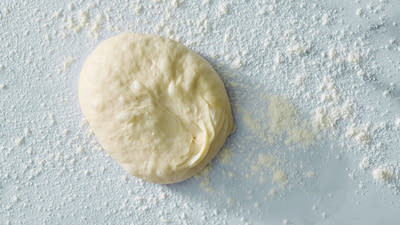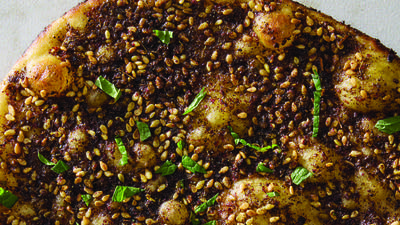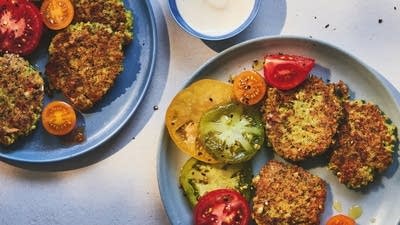
Chef David Chang is the hands and brains behind a clutch of restaurants in New York that fly under the banner Momofuku, including Noodle Bar, Ssam Bar, Milk Bar and Ko. Today they’re destination eateries, but that didn’t happen overnight.
Chang had to battle his way through self-doubt and hang-ups about authenticity to find out that the food that he wanted to cook was much better than the food that he thought he should cook. Now people stand in line for a very long time to get a taste. Once you do get a seat, you eat things like bacon dashi with potatoes and clams, shrimp and grits, and kimchi consommé -- food that crosses paths with Chang's Korean ancestry in Japan and America. Chang is the author of Momofuku.
Lynne Rossetto Kasper: You write in the book that one of the best-selling things at Ssam Bar is the cauliflower with fish sauce vinaigrette. How does cauliflower become a bestseller? What in heaven’s name have you done to cauliflower?
 Momofuku
Momofuku
David Chang: I know, it’s very strange. We have people eating tremendous amounts of vegetables that they avoided in their childhood. Originally, the Noodle Bar dish was kimchi puree with Brussels sprouts. Sometimes we would do roasted cauliflower. We found that these vegetables took an intense amount of pungent flavors and they married very well together. I think it was one of those beautiful accidents that happen in a professional kitchen.
LRK: In that recipe you can see the Korean and Asian background. But then I flip around in the book and I come to a recipe that really surprised me. Straight out of Charleston, S.C., -- shrimp and grits.
DC: In the book it was a story of me basically stealing polenta from one of the chefs who I used to work for, whose restaurant was up the street, Marco Canora. He had polenta and I had cooked a lot of Anson Mills at other restaurants.
It's beautiful stuff from Columbia, S.C. They really do mill it fresh every week -- that’s what makes it really special. They have certain heirloom strains of corn, which make the grits very great.
We’re eating this, and it was inspired by my partner at the time, who has his own restaurant now. He was telling me how he grew up in the country Colombia because his parents were diplomats. He would eat a version of hominy with basically fried eggs on top.
We were really down and out at that time, and I was like, "Well, what can I do to cheer him up?" So that’s why I went to Hearth and I took a couple quarts of the polenta. At the time we only had the ramen in stock. If I’d had chicken stock on hand, I would have made it with chicken stock.
I mounted it with butter. We had soy sauce on hand instead of salt. Soy and butter are a really magical combination, so I mounted it with butter and soy. That was the first version of it. Then I dropped a couple of the slow-poached eggs that we have in the book. I tasted it, and I was very surprised at the flavoring.
We all ate a hot and hearty bowl of that. That was a watershed moment for the restaurant. We just knew what flavor profiles in Asia we wanted to work with and the flavor profiles from the American South. It sort of happened.
LRK: It’s the way you made peace with fusion.
DC: Yes, I am embracing the word "fusion." I’ve been a strong advocate against the word "fusion," and I am now pro-fusion.
LRK: It’s very different when it comes about naturally rather than being superimposed on stuff. Where did you grow up?
 Chang's recipe: Fried (or Roasted) Cauliflower with Fish Sauce Vinaigrette
Chang's recipe: Fried (or Roasted) Cauliflower with Fish Sauce Vinaigrette
DC: I grew up in northern Virginia, right outside Washington, D.C. My father had a business that was in Richmond, and I had many family members, so I’d spend a considerable amount of my time in the Richmond area. I think that once you hit Charlottesville-Richmond area in Virginia, that’s the proper South. Anything above that is really the D.C. area.
I never realized my diet consisted of all sorts of strange things -- Korean food and then Waffle House-like Southern things on the weekends. I also played a lot of competitive golf as a child, so I would travel, specifically in the South, playing tournaments. I think that left a big impression on me in terms of how I view the world and how I -- in retrospect -- view food.
Everyone says childhood is very important in terms of how you view the world in the future, but it was chef Juan Mari Arzak who really nailed it on the head for me. He told me -- and this is one of his famous sayings -- you have to look at food through a child’s eyes, very innocent and playful. It’s when you have no judgments and you’re not jaded. You think about the origins of the dish, and it comes from something that you might have had and you don’t even remember it. Something stuck in your subconscious somewhere.
LRK: There is a childlike quality to your food as I look at these recipes. The playfulness and the imagination comes through.
Before you go...
Each week, The Splendid Table brings you stories that expand your world view, inspire you to try something new, and show how food connects us all. We rely on your generous support. For as little as $5 a month, you can have a lasting impact on The Splendid Table. And, when you donate, you’ll join a community of like-minded individuals who love good food, good conversation, and kitchen companionship. Show your love for The Splendid Table with a gift today.
Thank you for your support.
Donate today for as little as $5.00 a month. Your gift only takes a few minutes and has a lasting impact on The Splendid Table and you'll be welcomed into The Splendid Table Co-op.




